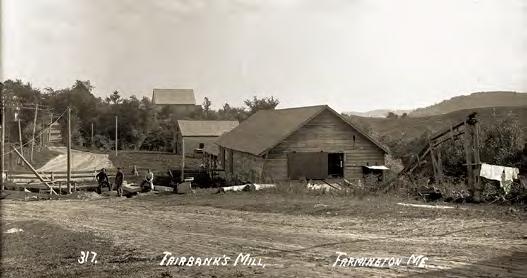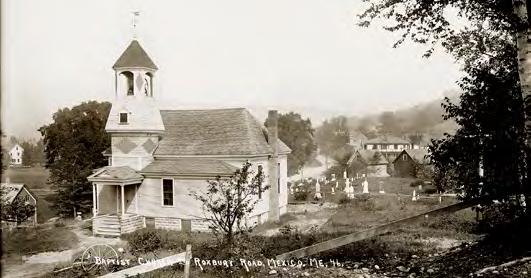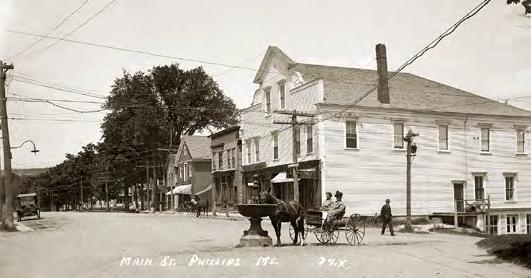
3 minute read
One Very Tall Yarn
A brief history of Skowhegan’s Maine Spinning Company
by Jeffrey Bradley
Advertisement
Where Skowhegan Island splits the mighty Kennebec River in two forms an excellent place for building a mill. And the mills came. The first spinning concern to appear on the site was Dickensian in nature. Wooden, drafty, ramshackle, it lacked any amenity, with even water, heat and restrooms nonexistent. And the workers alternately froze or sweltered, depending on the season. The ratchety machinery was cranky and dangerous, and waterpower inefficiently drove a noisy welter of chattering rocker arms, preposterously bobbing spindles, and the dizzying array of whirling leather belts that looped up and around the entire complex. In those dark days of child labor, cramped working spaces, and 16-hour days spent toiling dimly by candlelight, worker safety was hardly a concept. That initial gloomy edifice either burnt or was carried off in a flood, the exact cause remaining unclear; but what arose in its place, in 1922, sought to redress those hazards and more. By mirroring the changes sweeping other industries in urban settings across the nation, this new mill embarked on a course of using the latest energy technologies and approaches by management to materially improve output similarly to the Midwestern automobile industry.
And it came close to achieving those goals. Among the first local industries to replace waterpower with hydroelectricity to run machinery, the Maine Spinning Company also went far in overturning the old concepts that had dampened production. Besides taking worker needs and concerns into account, this new mill embodied a community-based, fully industrialized, near-automated complex employing a good deal of local labor that also
Skowhegan: 474-6223
Dover-Foxcroft: 659-3642 sackettandbrake.com proved a pioneer in the amazing changes overtaking textile manufacturing in rural Maine. For Skowhegan, all this was heady stuff.
New concepts cost money — construction, equipment, and the untold piles of yarn stock nearly totaled a cool $1,000,000 — but the investment paid off. During its heyday between the 1940s and 1970s over 300 people worked in double-shifts to produce 2 million pounds of yarn annually for the American market. Inside were three open floors of immense square footage reached by an elevator at either end that would glide below into the loading dock/basement or ascend to the 10,000 square foot addition later built on the roof. Revolutionary-for-the-times features such as an artesian well — bored through the basement bedrock, no mean feat in Maine’s hard granite — plus two bathrooms on every floor, double-glazed windows with screen- ing, automatic steam heat with dehumidifiers, even cutting-edge fire protection, were all installed. Equipment was designed with worker safety in mind, and even the noise levels were reduced for comfort. Designed by Lockwood, Greene & Company of Boston, and constructed by local contractors, the building has joined others designed by that firm now listed on the US National Register of Historic Places. In time, Maine Spinning evolved into the Solon Manufacturing Company, which fell a victim to overseas competition and closed for good in 2005. Still located on the same spot, the building has since stood mostly vacant and remains the only industrial structure left on Skowhegan Island.
It was a great source of pride, and over the course of more than a century, generations of families have labored there. For the town, the mill represented the height of modernity.
Its historic significance was not lost on them either; much fanfare and pomp accompanied the opening festivities. On a chill Saturday evening the second floor was converted into a ballroom replete with an orchestra directly from Boston, and each employee was allowed a companion. Caterers served a sumptuous banquet with the guests attended by a bevy of local beauties. Next day, the new factory was thrown open for viewing with the orchestra on hand to provide entertainment. In all,
(cont. on page 56)
(cont. from page 55)
1,500 attendees were reported — not bad for a mid-February weekend in snowy Skowhegan!
Initially, professional Syrian weavers were brought in to teach the employees the Bradford System for assessing the quality of wool in producing a medium worsted yarn. Worsted is a weight, not a fiber, and used mostly for knitting sweaters, scarves, blankets, and hats. The Syrians also instructed in the finer points of operating the new machinery to produce imported yarns in high volume, further instilling a sense of pride and loyalty in the workforce. Now yarns spun from fine imported materials like cashmere, mohair and alpaca could be sold throughout the country as high-end quality items. The process took nearly ten years, and the Syrians were gradually phased out as these new skills were mastered.
By the 1950s the Maine Spinning Company had reached the apex and came to be known as the most versatile mill that produced worsted yarn in the industry.
Preserving this important downtown structure helps to tie Skowhegan’s past to the future. Adjacent lies the Historic District encompassing the main business section, with the old mill the most conspicuous of many other historically significant buildings dating from 1880 to 1910 that include the Municipal Building and Opera House. And there, for a hundred fifty years and more, this building has stood and served the needs of Skowhegan. Still, it is a practical building designed for a specific purpose — namely, the spinning of yarns into fabric. And although much thought was given over to aesthetic appeal, it is decidedly difficult to prettify a structure such as a squat and hulking mill. Even today that looming brick and concrete façade can appear to glower at passersby, especially on a dank overcast day during inclement weather.







